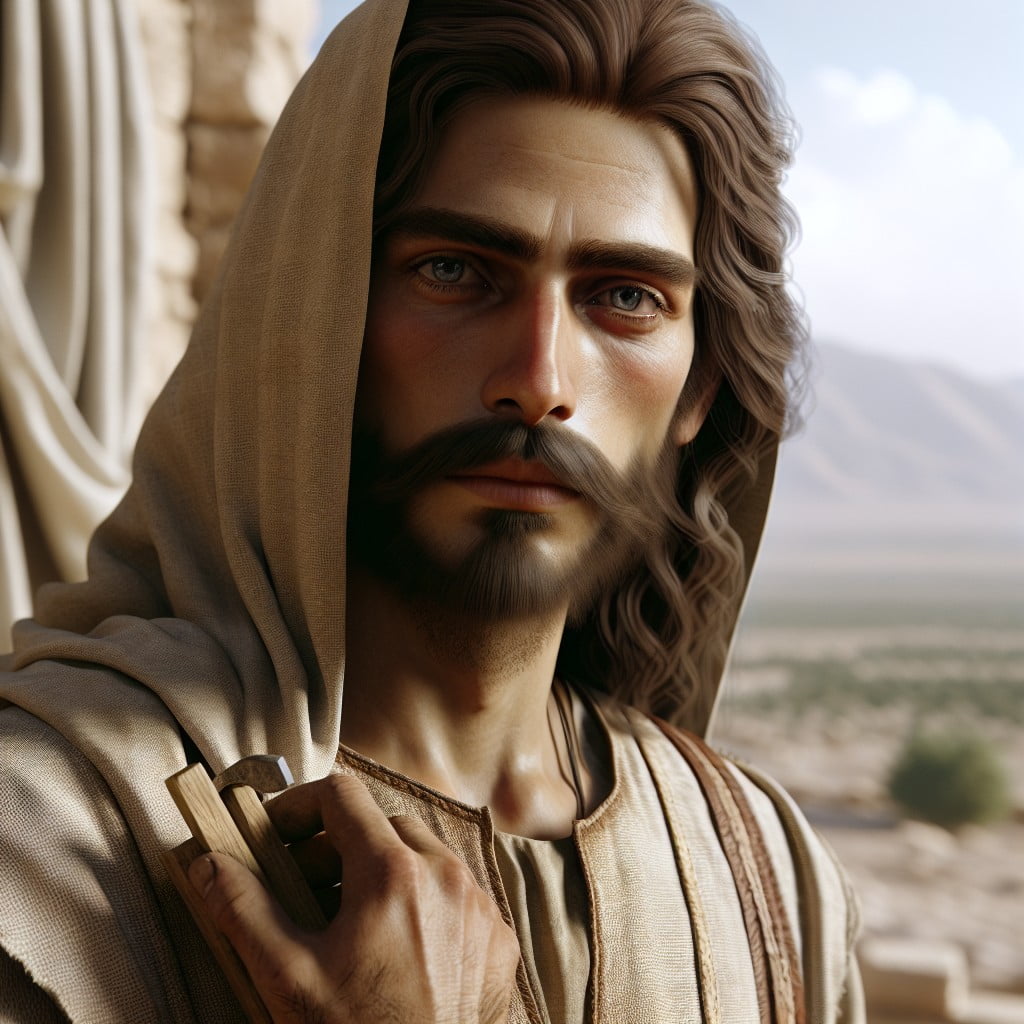Because the Bible does not specifically mention the color of Jesus’ eyes, it’s an intriguing exploration to ascertain how artistic perception and theological interpretation have influenced the depictions of Jesus’ eyes throughout history.
Key takeaways:
- Jesus likely had brown eyes based on regional characteristics and anthropological research.
- The Bible does not provide explicit descriptions of Jesus’ physical appearance, including his eye color.
- Symbolic descriptions in the Book of Revelation highlight Jesus’ divine attributes rather than his literal eye color.
- Artistic portrayals of Jesus’ eye color have varied throughout history and reflect the cultural backgrounds of the artists.
- Different eye colors in depictions of Jesus emphasize his humanity and divinity and promote inclusivity.
Historical Appearance of Jesus

When considering the historical appearance of Jesus, several factors are taken into account:
1. Regional Characteristics: Jesus was a Galilean Jew, and likely shared common Semitic traits of people living in the Near East at that time. This would suggest darker features, including more pigmented eyes common to that region.
2. Contemporary Descriptions: There are no extant contemporary descriptions of Jesus’ physical appearance. The first Christians did not emphasize physical depictions, focusing instead on his teachings and divinity.
3. Anthropological Research: Studies of skeletal remains from first-century Judea suggest that the average man had brown eyes, which Jesus most likely did as well. This fits into the general Mediterranean phenotype.
These points offer context for understanding the plausible historical appearance of Jesus and establish expectations for what his eye color may have been based on regional and genetic probability.
Biblical References to Jesus’ Appearance

In the Bible, specifics about Jesus’ physical features, including the color of his eyes, are scarce. The Gospels, which chronicle Jesus’ life and teachings, focus on his actions and parables rather than his appearance. Consequently, there are no explicit descriptions of his eye color.
The closest we come to a description in the scriptures is in the prophetic imagery of the Book of Isaiah (53:2) which suggests a rather ordinary and unremarkable presence: “He had no beauty or majesty to attract us to him, nothing in his appearance that we should desire him.” This passage emphasizes that Jesus’ message and mission were of greater importance than his physical attributes.
Additionally, the New Testament does not offer details that might reveal his specific eye color. This dearth of information indicates that for the authors of these texts, Jesus’ physical traits were not essential to his identity or his teachings.
Revelation’s Depiction of Jesus’ Eyes
The Book of Revelation offers a symbolic description of Jesus that differs from other New Testament accounts. In Revelation 1:14, His eyes are said to be “like a flame of fire.” This imagery is rich in metaphor, suggesting a being of divine insight and righteousness. Rather than a literal description, the “flame of fire” signifies penetrating wisdom and the capacity to see through all facades.
This particular depiction aligns with the book’s apocalyptic nature, emphasizing Jesus’ omniscience as the righteous judge rather than His physical characteristics. Such language is common in apocalyptic literature, which often uses vivid and symbolic imagery to convey its messages. Understanding these descriptions as symbolic rather than literal can lead to deeper insights into the text’s meaning and the perception of Jesus within the context of Revelation’s visions.
Interpreting Biblical Imagery and Descriptions
Interpreting the Bible’s visual descriptions requires understanding its use of metaphorical language. These images often served not as literal descriptors but as symbols designed to convey deeper spiritual truths.
- Biblical imagery is rich in symbolism; eyes like “flames of fire” in Revelation may suggest insight and divine judgment rather than actual eye color.
Jewish apocalyptic literature, which includes the Book of Revelation, is known for its symbolic and visionary content, providing context for these descriptions.
The focus on spiritual rather than physical characteristics in Scripture underscores the Bible’s intent to convey moral and spiritual lessons.
Recognizing cultural and historical contexts is vital, as attributes used in the Bible may have specific meanings in ancient times that differ from contemporary interpretations.
Images of Jesus serve as a focus for contemplation on his teachings and divine nature, rather than promoting a definitive physical representation.
Artistic Portrayals of Jesus Through History
Artistic representations of Jesus have varied greatly across different cultures and eras. During the early Christian period, Jesus was often depicted with a youthful, beardless appearance, a reflection of Roman artistic styles. As time progressed, particularly in the Byzantine art from the 6th century onwards, Jesus was frequently shown with brown eyes, aligning with common Middle Eastern traits.
Renaissance artists in Europe introduced another shift, with figures like Leonardo da Vinci painting Jesus with lighter features, including blue eyes, to resonate with European populations. This trend persisted, with many subsequent Western artworks reflecting the characteristics of their local populations rather than historical accuracy.
The variation in Jesus’ eye color in art, more than anything, demonstrates how artists have sought to create a relatable Christ figure for their audiences. As a result, the eye color chosen often says more about the time, place, and cultural context of the artist than about the historical Jesus himself.
Cultural Influence On Jesus’ Depicted Eye Color
Artistic renditions of Jesus often reflect the cultural and ethnic backgrounds of the artists creating them. Throughout history:
1. European Art – Dominated by blue-eyed depictions, aligning with the common traits of local populations.
2. Eastern Orthodox Iconography – Presents a more Semitic Jesus, likely with darker eyes, resonating with Middle Eastern heritage.
3. African and Latin American Art – Sometimes illustrates Jesus with brown eyes, reflecting the characteristics of indigenous people.
4. Contemporary Diversity – Modern interpretations are embracing a broader spectrum of eye colors, promoting inclusivity.
Each culture adapts the image of Jesus to its own understanding and aesthetic preferences, influencing perceptions and worship practices worldwide. These variations serve as a reminder of the universality of Jesus’ message, transcending beyond physical attributes.
Scientific Perspectives On Historical Eye Color
From a genetic standpoint, the population of the Middle East around 2,000 years ago predominantly possessed brown eyes, based on hereditary traits.
Modern DNA analysis techniques support this assumption, providing insight into prevalent physical characteristics of past populations.
Eye color is determined by multiple genes with brown being a dominant trait, especially in regions where sunlight is intense.
Genetic patterns suggest historical figures from this area, including religious figures, would likely have shared these common traits.
Moreover, environmental factors play a role in the evolution of eye color.
The strong sunlight of the Middle Eastern region would historically favor darker eyes due to the protective benefits against ultraviolet radiation.
Thus, in considering the scientific evidence and the inheritance patterns of eye color, the probability points toward darker-eyed individuals in Jesus’ time and place.
Implications of Jesus’ Eye Color in Art and Worship
In art, Jesus’ eye color often mirrors the cultural context of the artist rather than historical accuracy. This reflects an attempt to create a relatable Jesus for every audience, bridging the gap between the divine and the earthly. Worship practices may similarly adapt Jesus’ image to feel more personal and immediate to the congregation.
The varied depictions of Jesus’ eyes have played a role in the portrayal of his humanity and divinity. Lighter eyes might be used to emphasize a mystical nature, while darker eyes could highlight Jesus’ human aspects. This duality reinforces the theological concept of Jesus as both human and divine.
Additionally, differing eye colors across cultures and denominations may signal an inclusive message, suggesting that Jesus transcends ethnicity and is a figure for all humankind. However, this inclusive intention does not come without controversy; discussions about the authenticity vs. symbolism in his portrayal often arise within the faith community.
In summary, the implications of Jesus’ eye color in art and worship underscore the complex intersection between historical representation, cultural significance, and theological reflection.